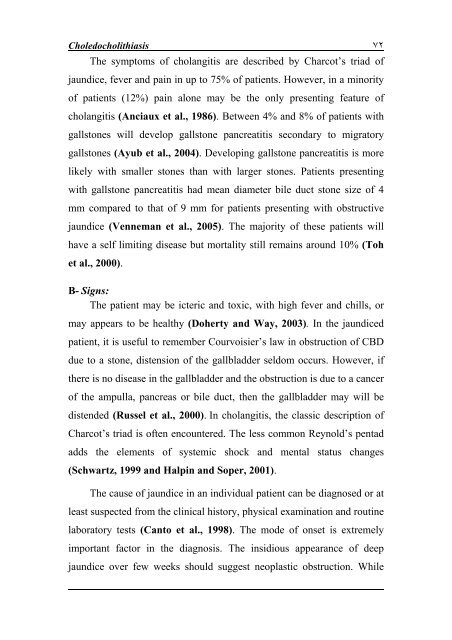Parasites and Biliary stones
Parasites and Biliary stones
Parasites and Biliary stones
Create successful ePaper yourself
Turn your PDF publications into a flip-book with our unique Google optimized e-Paper software.
Choledocholithiasis ٧٢<br />
The symptoms of cholangitis are described by Charcot’s triad of<br />
jaundice, fever <strong>and</strong> pain in up to 75% of patients. However, in a minority<br />
of patients (12%) pain alone may be the only presenting feature of<br />
cholangitis (Anciaux et al., 1986). Between 4% <strong>and</strong> 8% of patients with<br />
gall<strong>stones</strong> will develop gallstone pancreatitis secondary to migratory<br />
gall<strong>stones</strong> (Ayub et al., 2004). Developing gallstone pancreatitis is more<br />
likely with smaller <strong>stones</strong> than with larger <strong>stones</strong>. Patients presenting<br />
with gallstone pancreatitis had mean diameter bile duct stone size of 4<br />
mm compared to that of 9 mm for patients presenting with obstructive<br />
jaundice (Venneman et al., 2005). The majority of these patients will<br />
have a self limiting disease but mortality still remains around 10% (Toh<br />
et al., 2000).<br />
B- Signs:<br />
The patient may be icteric <strong>and</strong> toxic, with high fever <strong>and</strong> chills, or<br />
may appears to be healthy (Doherty <strong>and</strong> Way, 2003). In the jaundiced<br />
patient, it is useful to remember Courvoisier’s law in obstruction of CBD<br />
due to a stone, distension of the gallbladder seldom occurs. However, if<br />
there is no disease in the gallbladder <strong>and</strong> the obstruction is due to a cancer<br />
of the ampulla, pancreas or bile duct, then the gallbladder may will be<br />
distended (Russel et al., 2000). In cholangitis, the classic description of<br />
Charcot’s triad is often encountered. The less common Reynold’s pentad<br />
adds the elements of systemic shock <strong>and</strong> mental status changes<br />
(Schwartz, 1999 <strong>and</strong> Halpin <strong>and</strong> Soper, 2001).<br />
The cause of jaundice in an individual patient can be diagnosed or at<br />
least suspected from the clinical history, physical examination <strong>and</strong> routine<br />
laboratory tests (Canto et al., 1998). The mode of onset is extremely<br />
important factor in the diagnosis. The insidious appearance of deep<br />
jaundice over few weeks should suggest neoplastic obstruction. While
















